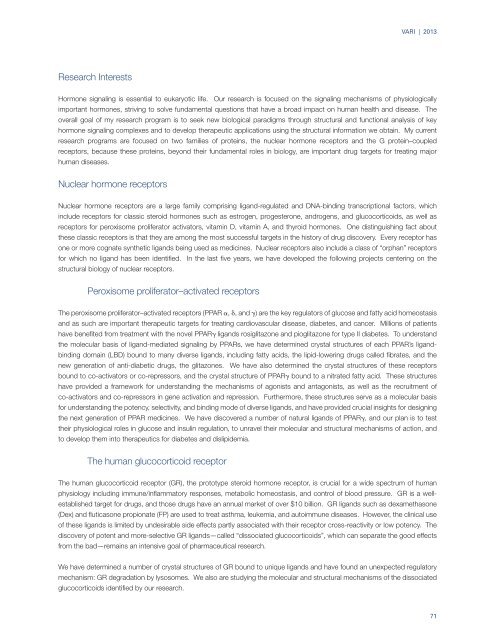2013 Scientific Report
Create successful ePaper yourself
Turn your PDF publications into a flip-book with our unique Google optimized e-Paper software.
VARI | <strong>2013</strong><br />
Research Interests<br />
Hormone signaling is essential to eukaryotic life. Our research is focused on the signaling mechanisms of physiologically<br />
important hormones, striving to solve fundamental questions that have a broad impact on human health and disease. The<br />
overall goal of my research program is to seek new biological paradigms through structural and functional analysis of key<br />
hormone signaling complexes and to develop therapeutic applications using the structural information we obtain. My current<br />
research programs are focused on two families of proteins, the nuclear hormone receptors and the G protein–coupled<br />
receptors, because these proteins, beyond their fundamental roles in biology, are important drug targets for treating major<br />
human diseases.<br />
Nuclear hormone receptors<br />
Nuclear hormone receptors are a large family comprising ligand-regulated and DNA-binding transcriptional factors, which<br />
include receptors for classic steroid hormones such as estrogen, progesterone, androgens, and glucocorticoids, as well as<br />
receptors for peroxisome proliferator activators, vitamin D, vitamin A, and thyroid hormones. One distinguishing fact about<br />
these classic receptors is that they are among the most successful targets in the history of drug discovery. Every receptor has<br />
one or more cognate synthetic ligands being used as medicines. Nuclear receptors also include a class of “orphan” receptors<br />
for which no ligand has been identified. In the last five years, we have developed the following projects centering on the<br />
structural biology of nuclear receptors.<br />
Peroxisome proliferator–activated receptors<br />
The peroxisome proliferator–activated receptors (PPAR a, d, and g) are the key regulators of glucose and fatty acid homeostasis<br />
and as such are important therapeutic targets for treating cardiovascular disease, diabetes, and cancer. Millions of patients<br />
have benefited from treatment with the novel PPARg ligands rosiglitazone and pioglitazone for type II diabetes. To understand<br />
the molecular basis of ligand-mediated signaling by PPARs, we have determined crystal structures of each PPAR’s ligandbinding<br />
domain (LBD) bound to many diverse ligands, including fatty acids, the lipid-lowering drugs called fibrates, and the<br />
new generation of anti-diabetic drugs, the glitazones. We have also determined the crystal structures of these receptors<br />
bound to co-activators or co-repressors, and the crystal structure of PPARg bound to a nitrated fatty acid. These structures<br />
have provided a framework for understanding the mechanisms of agonists and antagonists, as well as the recruitment of<br />
co-activators and co-repressors in gene activation and repression. Furthermore, these structures serve as a molecular basis<br />
for understanding the potency, selectivity, and binding mode of diverse ligands, and have provided crucial insights for designing<br />
the next generation of PPAR medicines. We have discovered a number of natural ligands of PPARg, and our plan is to test<br />
their physiological roles in glucose and insulin regulation, to unravel their molecular and structural mechanisms of action, and<br />
to develop them into therapeutics for diabetes and dislipidemia.<br />
The human glucocorticoid receptor<br />
The human glucocorticoid receptor (GR), the prototype steroid hormone receptor, is crucial for a wide spectrum of human<br />
physiology including immune/inflammatory responses, metabolic homeostasis, and control of blood pressure. GR is a wellestablished<br />
target for drugs, and those drugs have an annual market of over $10 billion. GR ligands such as dexamethasone<br />
(Dex) and fluticasone propionate (FP) are used to treat asthma, leukemia, and autoimmune diseases. However, the clinical use<br />
of these ligands is limited by undesirable side effects partly associated with their receptor cross-reactivity or low potency. The<br />
discovery of potent and more-selective GR ligands—called “dissociated glucocorticoids”, which can separate the good effects<br />
from the bad—remains an intensive goal of pharmaceutical research.<br />
We have determined a number of crystal structures of GR bound to unique ligands and have found an unexpected regulatory<br />
mechanism: GR degradation by lysosomes. We also are studying the molecular and structural mechanisms of the dissociated<br />
glucocorticoids identified by our research.<br />
71
















